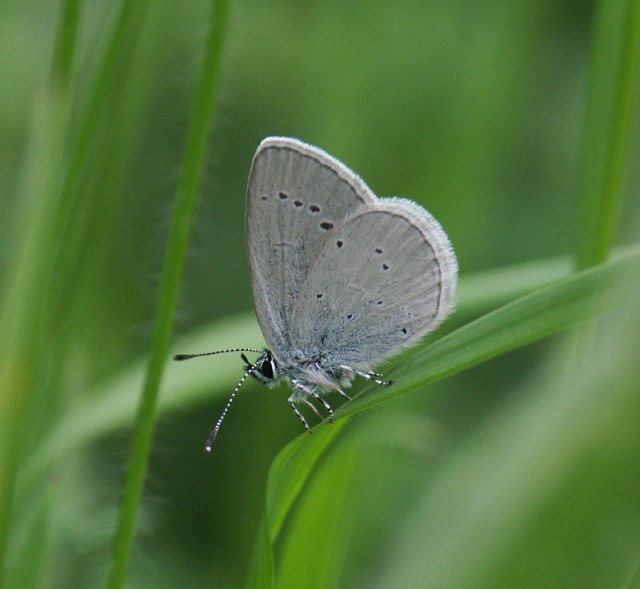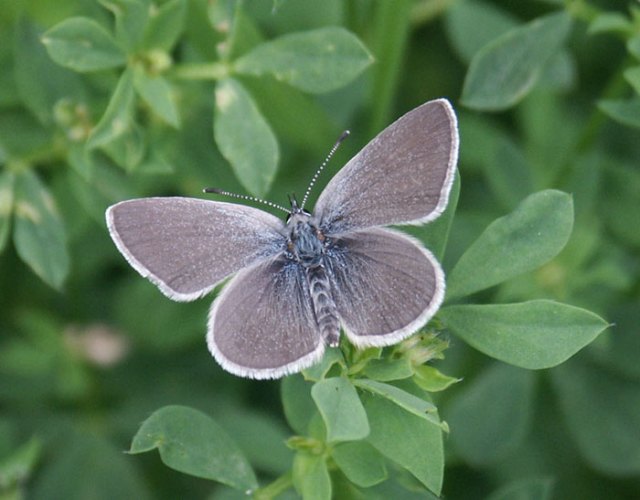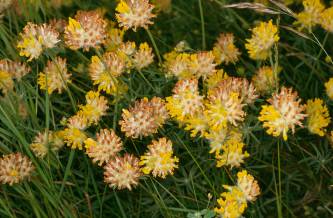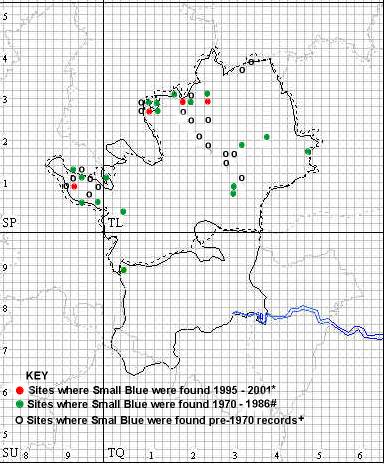 |
 |
 |
| Small Blue © photo: Allen Beechey |
Small Blue © photo: Allen Beechey |
Small Blues mating © photo: Sandra Standbridge |
In 2007 the Small Blue became a UK Priority Species. The Small Blue is identified in the
Thames Regional Action Plan as having Medium Priority status but new knowledge of its distribution and rates of decline thanks to the
Millennium Atlas demonstrated why species should be given such urgent higher priority.
A copy of the Butterfly Conservation Species Action Plan can be downloaded here
Although widely distributed across Britain the Small Blue is rare across most of its range. Despite being fairly widespread within the Thames Region (mainly across the Chilterns and the Berkshire Downs) it is absent from Middlesex and Hertfordshire. The last record from a confirmed site in Hertfordshire was in 2002.
The tiny pale blue, disk-like egg is laid singly within the flower heads of the sole larval foodplant, Kidney Vetch (Anthyllis vulneraria) in June. These usually hatch within one to three weeks.
 |
| Kidney Vetch (Anthyllis vulneraria) © photo: Malcolm Storey BioImages - Virtual Field-Guide (UK) |
The young pale pinkish-grey caterpillar burrows into the flower to feed on developing seed tissue, but by late July lives openly on the seed-head when it is most likely to be found. Damage, in the form of a series of holes in the base of the flowers, is a telltale sign that the caterpillars have been present. The full-grown caterpillar leaves the plant in high summer to hibernate until the following April in soil crevices or beneath surface vegetation.
The tiny chrysalis which forms in April and May, despite being at ground level, is almost impossible to find.
Emergence of Britain's smallest resident butterfly typically begins in mid-May with peak numbers flying in early June with a few lasting into July. A small second generation may emerge in late-July/August and fly until early September. Recent Hertfordshire records have spanned 14th May to 20th June and 9th to 21st August.
The wingspan may vary between 20-30mm but on average is 24mm (1"). Both sexes have brown (pattern-less) upper-wings edged with white, although the male is distinguished by a dusting of silvery-blue scales near the body. The under-wings resemble those of Holly Blue, being silver-grey with small black spots (consisting of an uneven row near the wings outer edge and a few isolated spots nearer the body). The flight has been described as weak and fluttery and is only likely to be confused with Brown Argus (the orange spots on the wing surfaces of this species are characteristic). The adult will use Kidney Vetch, Bird's-foot Trefoil and Horseshoe Vetch as a nectar source.
Small Blues live in small close knit colonies where Kidney Vetch is present, usually in warm dry sheltered grassland hollows. A couple of plants may be sufficient to support a colony. Colonies are likely to number less than 30 individuals during the peak flight period and when last seen in Hertfordshire five individuals were the most seen in any one-day. The colony usually flies and breeds in the same few square metres of ground year after year. The males, especially, perch for long periods on tussocks and small shrubs basking with their wings half-open only flying briefly to intercept a passing female. The females spend much of her time around Kidney Vetch flowers selecting prominent plants growing in sheltered depressions. All of these factors conspire to make it is very easy to overlook the butterfly.
Typical sites are likely to comprise sheltered, sparsely vegetated south-facing sides of abandoned chalk and lime pits and disturbed chalk soils on downland, road and rail embankments.
Despite formerly being more widespread the species is likely to be restricted to the chalk escarpment of the north and west of the county in a zone a few miles either side of a line drawn between Royston and Tring. This area corresponds with the greatest distribution of Kidney Vetch although today the plant is increasingly rare due to scrub encroachment and lack of ground disturbance that is occasionally required to prevent it being overwhelmed by grass species. In the last ten years the few sightings of this butterfly have been largely limited to the Hitchin/Letchworth/Weston area with single records from Hexton and Tring. This is the area most likely to hold undiscovered Small Blue colonies. In 2009 there was a report (and photo) of a singleton at Telegraph Hill in the north of the county. In addition there are several colonies very close to the Hertfordshire border near Tring at College Lakes and nearby Church End (both in Buckinghamshire). Recent restoration management work at Aldbury Nowers has included the planting of kidney vetch. Additionally when the chalk cutting of the Baldock Bypass was constructed, kidney vetch was included in planting schemes. However, elsewhere Kidney Vetch is very sparsely and widely distributed in the center and west of the county and any group of plants, no matter how small, should be inspected for eggs, caterpillars and adults at the right times of year.
Given the rarity of Small Blue in the County and the significant decline in recent years of the distribution of Kidney Vetch we are keen to receive information on both species. If you see either please record the place (preferably with a six-figure Ordnance Survey grid reference), the date, time, number, habitat and anything other information that may assist us in protecting these species.
Click on map for details

Andrew Palmer